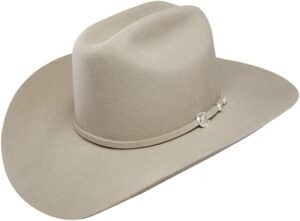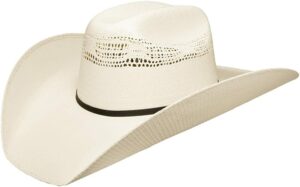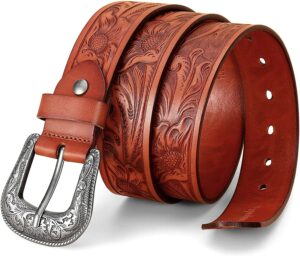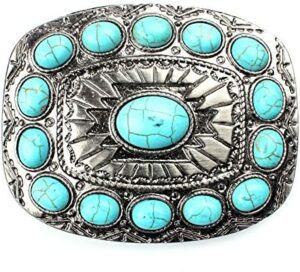Western Cowboy Wear (History, Plus 5 Things You NEED to Know)


Western style has become iconic in modern-day culture and carries with it, a boastful, confident attitude. This is due to the rugged and individualistic demeanor of the Western cowboy, as depicted within Western cinema, stories, and Western culture.
The history of Western wear stems from the traditional clothing styles of North American settlers in the mid-1800s. These settlers were moving westward and therefore the clothing style was acclimated to the rough environment of the new frontier.
Some Western Cowboy Wear items include:
- Cowboy Hat
- Cowboy Boots
- Denim Jeans
- Denim Jacket
- Bandana
- Poncho
- Western Dress Shirt
- Belt Buckle
- Leather Belt
The deeper roots of the Western cowboy style really go back further than most realize. As far back as the 16th century with the arrival of the Spanish to the Americas. These Spanish settlers brought with them horses which led to the ability to herd, ranch, and raise livestock in what is now California, New Mexico, Arizona, and Texas.
The Cowboy Hat
The cowboy hat is probably the most distinct piece of western wear and also the most crucial part of a cowboy’s get-up. Sporting a high crown and wide brim, these hats were designed to keep the cowboy cool and shaded from the sun.
Wide-brimmed hats such as the cowboy hat were common in cultures that had to deal with hot and sunny climates. It is hypothesized that the cowboy hat drew inspiration from the wide-brimmed hats worn by the Mexican vaqueros, more commonly known as the sombrero. The vaqueros were also skilled horsemen and cattle herders; real cowboys in their own right.
Eventually, the cowboy hat came to be sported by famous Western figures and cowboys such as Buffalo Bill and John Wayne. This further pushed the cowboy hat into prominence, becoming a staple of the Western outfit.
Felt Cowboy Hat
Felt hats are typically more expensive than straw hats and serve more purposes. Historically, felt hats protected cowboys (and girls) from the sun during the day and kept their heads warm in the evening (especially in the desert.) A felt could also scoop up water to hold for a thirsty mount or fan a campfire flame. Felts can be crafted from beaver, buffalo, rabbit or mink hides and these hats are typically worn during the winter months.
Straw Cowboy Hat
Straw hats are better to wear during warmer weather, as they don’t hold the heat in as much as felt ones do. They are lightweight, breathable and generally less expensive than felt hats.
” There’s an unwritten rule about when to wear felt versus straw hats. Among those in the Western lifestyle, it’s customary between Memorial Day and Labor Day to wear a straw hat and a felt between Labor Day and Memorial Day. “
The Cowboy Boot
Just like the cowboy hat, the cowboy boot is a very distinct and crucial element of cowboy wear. Also, like the cowboy hat, the Boot was designed for external factors, in particular, to meet the needs of working long hours in a hot climate, against the rough terrain of the new frontier.
The height of the boot on a wearer’s leg would protect from different hazards often found in the outback, such as brush, thorns, and snakes. From a practical standpoint, the pointed toe allows for the foot to easily slip into the stirrup, while the low heel prevents slipping through the stirrup.
As the cowboy boot became more prominent in the early 1900s, it was no longer just designed for practicality, but also for style and decoration. This can be seen in the fact that cowboy boots can now be found sporting a variety of designs and materials such as buffalo leather, snakeskin, or even alligator.
Denim
The cowboy outfit isn’t complete without a nice pair of denim jeans or perhaps a denim jacket. Denim has been used by the cowboy since the start of Western culture but the origins of denim can be traced back to 17th-century France, where it was first produced.
Due to denim being cheap and durable, it was soon adopted by working people in the US as the preferred fabric for miners, cowboys, and farmers. This fabric could easily resist wear and tear from the daily duties of these common workers and soon not only was it practical but also stylish.
“What is the first Western-style clothing brand?” Levi Strauss patented the idea of blue jeans on May 20th, 1973. Shortly afterward in the early 1900s, Levi Strauss & Co. started producing denim jeans specifically for cowboys and rodeo performers. This was due in part to Levi’s first pair of jeans, the 501, which grew in popularity within the cowboy and Western world. The 501 became so popular within these niches because of its high-duty and quality denim, that reinforced high-stress areas of the jean which would be prone to wear and tear.
After the 19th century, other competitors in the denim market began to appear: namely Wrangler (1905) and Lee (1911). After the 19th century, other competitors in the denim market began to appear: namely Wrangler (1905) and Lee (1911).
Denim has continued to be a staple of modern Western style, being paramount with the rugged lifestyle of the Western outback and American Cowboy.
Leather
Leather has a robust history within Western wear and dates back to the 1800s. Just like denim, leather became popular due to its durability and ability to combat the rough elements commonly faced in the Western frontier.
Not only was leather used for typical Western clothing pieces such as the boot or chaps, but it was also used for saddles, spurs, and cuffs. The most iconic leather clothing item was the cowboy boot.
“Why did cowboys wear cow boots?” Not only did it protect the legs of horseback riders with its tall shaft, but the leather was the perfect material to protect cowboys from snake bites, cactuses, and other frontier hazards.
In the early 1900s, leather bomber jackets were a common accessory among US military pilots and other personnel which helped contribute to the rise and popularity of the Western-style jacket. This jacket would normally sport ornamental stitching, complemented with studs and other Western-Wear adornments.
There is also the highly prized leather saddle. The saddle was looked at as both a tool and a symbol of caliber. For this reason, the saddle was usually a cowboy’s most prized possession. Horses were expensive and most cowboys did not own one, but by owning a saddle, a cowboy could easily land a job. Riders would spend most of their day in the saddle, which would eventually break the saddle into the rider’s particular shape. The saddle would last up to 20 years, becoming a sentimental and important part of the cowboy lifestyle.
Leather chaps were another popular leather Western item. These protective garments were designed to protect cowboys’ legs while riding horseback through brush and other obstacles.
Today, leather remains an important material in Western wear, with cowboy boots, jackets, vests, and chaps being iconic symbols of Western style.
Cowboy Belt Buckle
Like cowboy leather, buckles can also be traced back as far as the 1800s. They were used to keep cowboys’ pants up while horseback riding.
However, it wasn’t always like this and initially, suspenders were used. The inspiration for the cowboy belt buckle, just like leather jackets, came from the US military.
During the civil war in the mid-1800s, the US military started using belt buckles, and eventually, the buckles became mass-produced and extremely common. Their usage eventually spread to the cowboy as an alternative to suspenders.
As time went on, and Western culture grew, buckles became a more ingrained part of Western style. This can be traced to when cowboys first began to compete in different Western events such as rodeos, and buckles became a common prize. These prize buckles would showcase a cowboy’s skill and reputation. With this, the buckle became more decorative and solidified as a symbol of Western wear.
Like other aspects of the Western style, with the popularity of Hollywood Westerns, buckles became more ingrained within Western culture. This led to increased demand by the general public, that saw these ornate buckles showcased on their favorite Western star and wanted to emulate them.
To this day, cowboy buckles remain a popular part of the Western outfit and come in a diverse array of styles and designs.











